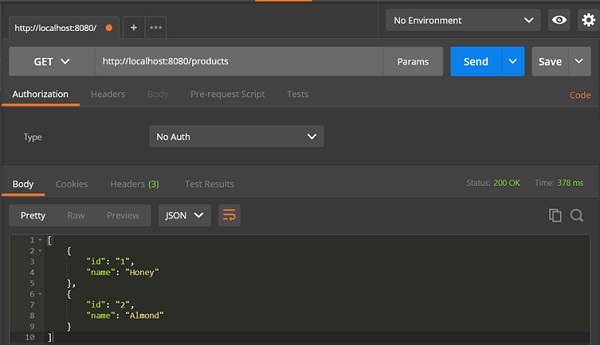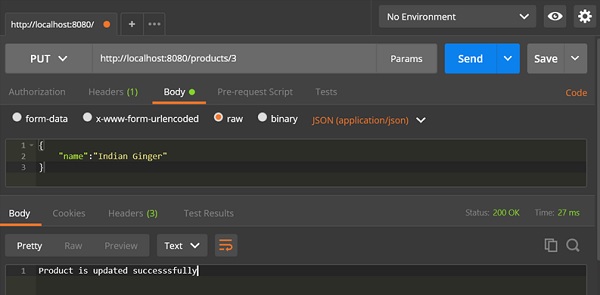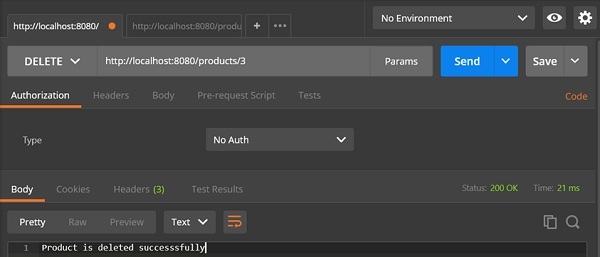- RESTful Web服务教程Spring Boot RESTful Web服务(1)
- Spring Boot – RESTful Web 服务简介(1)
- Spring Boot – RESTful Web 服务简介
- 使用Spring Boot的RESTful Web服务简介
- 使用Spring Boot的RESTful Web服务简介(1)
- 使用Spring Boot的RESTful Web服务简介
- 使用Spring Boot的RESTful Web服务简介(1)
- RESTful Web服务-方法
- log4j 与 Spring Boot RESTful 服务 - Java (1)
- log4j 与 Spring Boot RESTful 服务 - Java 代码示例
- RESTful Web 服务 API (1)
- RESTful Web服务教程
- RESTful Web服务教程(1)
- RESTful Web服务-资源
- RESTful Web服务-资源(1)
- RESTful Web服务-简介
- RESTful Web服务-简介(1)
- RESTful Web服务-无状态
- RESTful Web服务-无状态(1)
- 讨论RESTful Web服务(1)
- 讨论RESTful Web服务
- 初始化RESTful Web服务
- 初始化RESTful Web服务
- 初始化RESTful Web服务(1)
- RESTful Web服务-缓存(1)
- RESTful Web服务-缓存
- RESTful Web 服务中的协议 (1)
- RESTful Web 服务 API - 任何代码示例
- RESTful Web服务-环境设置
📅 最后修改于: 2020-11-11 05:34:31 🧑 作者: Mango
Spring Boot为构建企业应用程序的RESTful Web服务提供了很好的支持。本章将详细说明有关使用Spring Boot构建RESTful Web服务的信息。
注–为了构建RESTful Web服务,我们需要将Spring Boot Starter Web依赖项添加到构建配置文件中。
如果您是Maven用户,请使用以下代码在pom.xml文件中添加以下依赖项-
org.springframework.boot
spring-boot-starter-web
如果您是Gradle用户,请使用以下代码在build.gradle文件中添加以下依赖项。
compile('org.springframework.boot:spring-boot-starter-web')
下面给出了完整的构建配置文件Maven build – pom.xml的代码-
4.0.0
com.tutorialspoint
demo
0.0.1-SNAPSHOT
jar
demo
Demo project for Spring Boot
org.springframework.boot
spring-boot-starter-parent
1.5.8.RELEASE
UTF-8
UTF-8
1.8
org.springframework.boot
spring-boot-starter-web
org.springframework.boot
spring-boot-starter-test
test
org.springframework.boot
spring-boot-maven-plugin
下面给出了完整的构建配置文件Gradle Build – build.gradle的代码-
buildscript {
ext {
springBootVersion = '1.5.8.RELEASE'
}
repositories {
mavenCentral()
}
dependencies {
classpath("org.springframework.boot:spring-boot-gradle-plugin:${springBootVersion}")
}
}
apply plugin: 'java'
apply plugin: 'eclipse'
apply plugin: 'org.springframework.boot'
group = 'com.tutorialspoint'
version = '0.0.1-SNAPSHOT'
sourceCompatibility = 1.8
repositories {
mavenCentral()
}
dependencies {
compile('org.springframework.boot:spring-boot-starter-web')
testCompile('org.springframework.boot:spring-boot-starter-test')
}
在继续构建RESTful Web服务之前,建议您了解以下注释-
休息控制器
@RestController批注用于定义RESTful Web服务。它提供JSON,XML和自定义响应。其语法如下所示-
@RestController
public class ProductServiceController {
}
请求映射
@RequestMapping批注用于定义访问REST端点的请求URI。我们可以定义Request方法来消耗和产生对象。默认请求方法是GET。
@RequestMapping(value = "/products")
public ResponseEntity请求正文
@RequestBody批注用于定义请求正文内容类型。
public ResponseEntity路径变量
@PathVariable批注用于定义自定义或动态请求URI。请求URI中的Path变量定义为大括号{},如下所示-
public ResponseEntity请求参数
@RequestParam批注用于从请求URL读取请求参数。默认情况下,它是必需的参数。我们还可以为请求参数设置默认值,如下所示:
public ResponseEntityGET API
默认的HTTP请求方法是GET。此方法不需要任何请求正文。您可以发送请求参数和路径变量来定义定制URL或动态URL。
下面显示了定义HTTP GET请求方法的示例代码。在此示例中,我们使用HashMap来存储产品。请注意,我们使用POJO类作为要存储的产品。
在这里,请求URI是/ products ,它将返回HashMap存储库中的产品列表。下面给出了包含GET方法REST Endpoint的控制器类文件。
package com.tutorialspoint.demo.controller;
import java.util.HashMap;
import java.util.Map;
import org.springframework.http.HttpStatus;
import org.springframework.http.ResponseEntity;
import org.springframework.web.bind.annotation.RequestMapping;
import org.springframework.web.bind.annotation.RestController;
import com.tutorialspoint.demo.model.Product;
@RestController
public class ProductServiceController {
private static Map productRepo = new HashMap<>();
static {
Product honey = new Product();
honey.setId("1");
honey.setName("Honey");
productRepo.put(honey.getId(), honey);
Product almond = new Product();
almond.setId("2");
almond.setName("Almond");
productRepo.put(almond.getId(), almond);
}
@RequestMapping(value = "/products")
public ResponseEntity POST API
HTTP POST请求用于创建资源。此方法包含请求正文。我们可以发送请求参数和路径变量来定义自定义或动态URL。
以下示例显示了用于定义HTTP POST请求方法的示例代码。在此示例中,我们使用HashMap来存储产品,其中产品是POJO类。
在这里,请求URI是/ products ,在将产品存储到HashMap存储库后,它将返回String。
package com.tutorialspoint.demo.controller;
import java.util.HashMap;
import java.util.Map;
import org.springframework.http.HttpStatus;
import org.springframework.http.ResponseEntity;
import org.springframework.web.bind.annotation.RequestBody;
import org.springframework.web.bind.annotation.RequestMapping;
import org.springframework.web.bind.annotation.RequestMethod;
import org.springframework.web.bind.annotation.RestController;
import com.tutorialspoint.demo.model.Product;
@RestController
public class ProductServiceController {
private static Map productRepo = new HashMap<>();
@RequestMapping(value = "/products", method = RequestMethod.POST)
public ResponseEntity PUT API
HTTP PUT请求用于更新现有资源。此方法包含一个请求正文。我们可以发送请求参数和路径变量来定义自定义或动态URL。
下面给出的示例显示了如何定义HTTP PUT请求方法。在此示例中,我们使用HashMap来更新现有产品,其中产品是POJO类。
这里的请求URI是/ products / {id} ,它将把产品后的String返回到HashMap存储库中。请注意,我们使用了路径变量{id} ,该变量定义了需要更新的产品ID。
package com.tutorialspoint.demo.controller;
import java.util.HashMap;
import java.util.Map;
import org.springframework.http.HttpStatus;
import org.springframework.http.ResponseEntity;
import org.springframework.web.bind.annotation.PathVariable;
import org.springframework.web.bind.annotation.RequestBody;
import org.springframework.web.bind.annotation.RequestMapping;
import org.springframework.web.bind.annotation.RequestMethod;
import org.springframework.web.bind.annotation.RestController;
import com.tutorialspoint.demo.model.Product;
@RestController
public class ProductServiceController {
private static Map productRepo = new HashMap<>();
@RequestMapping(value = "/products/{id}", method = RequestMethod.PUT)
public ResponseEntity 删除API
HTTP Delete请求用于删除现有资源。此方法不包含任何请求正文。我们可以发送请求参数和路径变量来定义自定义或动态URL。
下面给出的示例显示了如何定义HTTP DELETE请求方法。在此示例中,我们使用HashMap删除了现有产品,即POJO类。
请求URI为/ products / {id} ,从HashMap存储库中删除产品后,它将返回String。我们使用了路径变量{id} ,该变量定义了需要删除的产品ID。
package com.tutorialspoint.demo.controller;
import java.util.HashMap;
import java.util.Map;
import org.springframework.http.HttpStatus;
import org.springframework.http.ResponseEntity;
import org.springframework.web.bind.annotation.PathVariable;
import org.springframework.web.bind.annotation.RequestBody;
import org.springframework.web.bind.annotation.RequestMapping;
import org.springframework.web.bind.annotation.RequestMethod;
import org.springframework.web.bind.annotation.RestController;
import com.tutorialspoint.demo.model.Product;
@RestController
public class ProductServiceController {
private static Map productRepo = new HashMap<>();
@RequestMapping(value = "/products/{id}", method = RequestMethod.DELETE)
public ResponseEntity 本节为您提供完整的源代码集。请遵守以下代码以了解其各自的功能-
Spring Boot主应用程序类– DemoApplication.java
package com.tutorialspoint.demo;
import org.springframework.boot.SpringApplication;
import org.springframework.boot.autoconfigure.SpringBootApplication;
@SpringBootApplication
public class DemoApplication {
public static void main(String[] args) {
SpringApplication.run(DemoApplication.class, args);
}
}
POJO类– Product.java
package com.tutorialspoint.demo.model;
public class Product {
private String id;
private String name;
public String getId() {
return id;
}
public void setId(String id) {
this.id = id;
}
public String getName() {
return name;
}
public void setName(String name) {
this.name = name;
}
}
休息控制器类– ProductServiceController.java
package com.tutorialspoint.demo.controller;
import java.util.HashMap;
import java.util.Map;
import org.springframework.http.HttpStatus;
import org.springframework.http.ResponseEntity;
import org.springframework.web.bind.annotation.PathVariable;
import org.springframework.web.bind.annotation.RequestBody;
import org.springframework.web.bind.annotation.RequestMapping;
import org.springframework.web.bind.annotation.RequestMethod;
import org.springframework.web.bind.annotation.RestController;
import com.tutorialspoint.demo.model.Product;
@RestController
public class ProductServiceController {
private static Map productRepo = new HashMap<>();
static {
Product honey = new Product();
honey.setId("1");
honey.setName("Honey");
productRepo.put(honey.getId(), honey);
Product almond = new Product();
almond.setId("2");
almond.setName("Almond");
productRepo.put(almond.getId(), almond);
}
@RequestMapping(value = "/products/{id}", method = RequestMethod.DELETE)
public ResponseEntity 您可以创建一个可执行的JAR文件,并使用下面的Maven或Gradle命令运行spring boot应用程序,如下所示-
对于Maven,请使用以下所示的命令-
mvn clean install
在“ BUILD SUCCESS”之后,您可以在目标目录下找到JAR文件。
对于Gradle,请使用下面显示的命令-
gradle clean build
在“ BUILD SUCCESSFUL”之后,您可以在build / libs目录下找到JAR文件。
您可以使用下面显示的命令来运行JAR文件-
java –jar
这将在Tomcat端口8080上启动应用程序,如下所示-

现在,在POSTMAN应用程序中点击下面显示的URL,然后查看输出。
GET API URL是: http:// localhost:8080 / products

POST API URL是: http:// localhost:8080 / products

PUT API URL是: http:// localhost:8080 / products / 3

删除API URL是: http:// localhost:8080 / products / 3
